[ad_1]
The Atlantic Conveyor was constructed on the Tyne by Swan Hunter and delivered to Cunard in 1970 as a part of their contribution to the Atlantic Container Line consortium.
It might go on to be sunk by enemy motion within the 1982 Falkland Islands battle, the place it served as an plane ferry.
That is her story.
Earlier than the Falkland Islands Battle
The Atlantic Container Line (ACL) consortium was based in 1965, comprising Wallenius Strains (OW), Swedish America Line(SAL/Brostroms), The Transatlantic Steamship Firm Restricted (RABT) and Holland America Line (HAL).
The 4 had been later joined by the Cunard Steamship Firm and the French Compagnie Generale Transatlantique (CGT).
The Atlantic Conveyor was constructed on the Tyne by Swan Hunter and delivered to Cunard in 1970 as a part of their contribution to the Atlantic Container Line consortium.
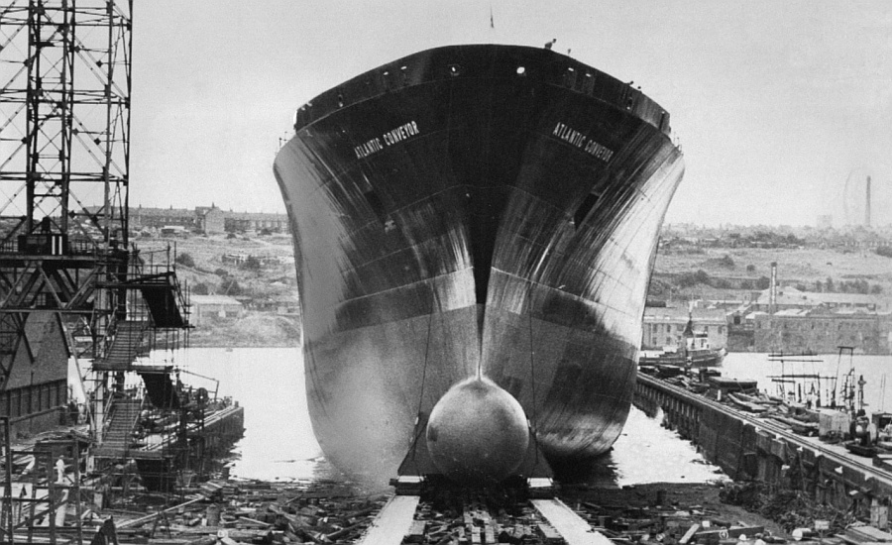
Vessels within the class included the Atlantic Crown (HAL), Atlantic Cinderella (HAL), Atlantic Cognac (CGT), Atlantic Champagne (CGT), Atlantic Causeway (Cunard), and the Atlantic Conveyor (Cunard).
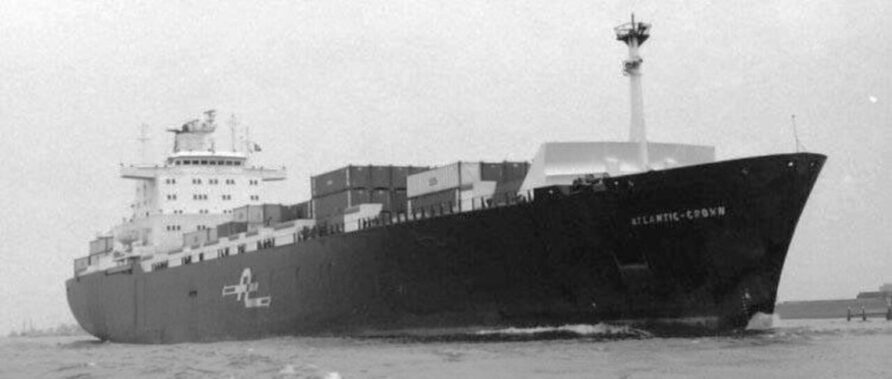
These had been revolutionary designs on the time, combining RORO and container storage in a single vessel, a CONRO.
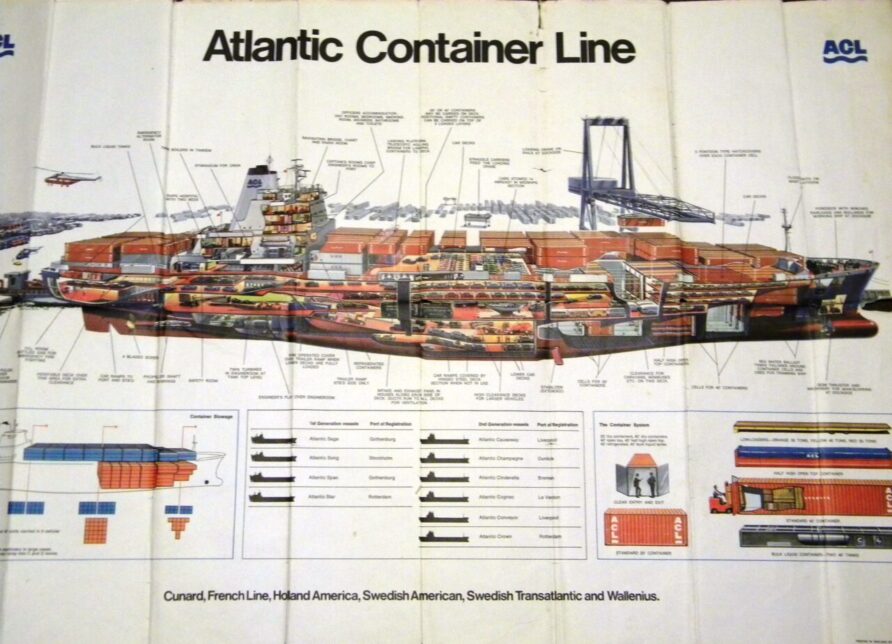
Every of them displaced slightly below 15,000 tonnes and after building, all began to visitors transatlantic routes and people to North Africa.

Falklands Necessities
By the start of April 1982, the invasion of the Falkland Islands by Argentina was imminent and sooner or later, after a quick firefight, Governor Rex Hunt ordered the Royal Marines garrison to give up.
Don’t make your self too cozy mate, we’ll be again.
Unknown British Royal Marine [as leaving, to Argentine guard]
Photographs of the inclined Royal Marines had been iconic however what was not extensively recognized on the time was that the troopers that ordered the Royal Marines to take action had been admonished by an Argentine officer who then requested the Royal Marines rise up and be happy with themselves.
On the third of April 1982, the UN handed Decision 502, demanding the withdrawal of Argentine forces, a cessation of hostilities and a political resolution.
This got here as a shock to the Argentine management, they genuinely thought the UN would assist their intervention.
By then, the ‘British Army Machine’ was beginning to transfer…
The Royal Navy (RN) and Royal Fleet Auxiliary (RFA) ships weren’t practically sufficient for 3CDO, not to mention the eventual drive that sailed, assist can be wanted.
One should keep in mind in 1982 UK forces had been configured for ‘Chilly Battle’ NATO duties and expeditionary capabilities didn’t have the identical precedence as given to the anticipated Warsaw Pact thrust into Western Europe.
To assist the logistics effort, a number of civilian vessels had been due to this fact requisitioned below the ‘Ships Taken Up From Commerce’ (STUFT) preparations.
Different vessels had been chartered and in whole, simply over 40 civilian vessels of many varieties took half within the battle.
After some preparation, 4 Chinook helicopters from 18 Squadron RAF had been indifferent to RNAS Culdrose to assist the duty drive by ferrying all method of provides to the ships, together with a 7-tonne drive shaft bearing.
The unique plan was to deploy 4 plane to the Process Pressure and one at Ascension. It shouldn’t be forgotten that the Chinook had at the moment, solely been in service for a short while.
Harriers and Sea Harrier groups began preparations; the Harrier GR.3 was fitted with radar warning receivers and even modified to hold and fireplace the Sidewinder air-to-air missile.
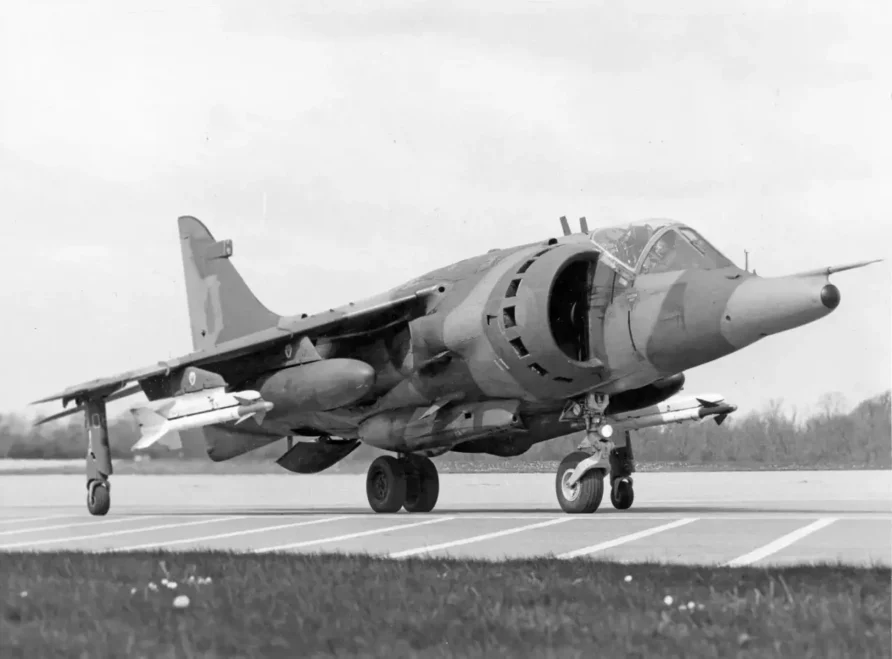
Further Harrier GR.3 modifications included tie-down factors on the outriggers, modifications to the nostril wheel, varied holes both drilled or plugged and modifications to the navigation system, all to permit them to deploy from plane carriers.
After a gathering on the MoD on the 14th of April 1982 throughout which the idea was advanced, the SS Atlantic Conveyor was designated to hold a number of Harriers and helicopters south, the Harriers had been to interchange anticipated fight losses.
The Atlantic Conveyor was due to this fact NOT to be an plane service conversion, however primarily a transport vessel for Harriers and Chinooks,
She sailed from Liverpool the day after, certain for Devonport.
After arriving at Devonport on the sixteenth of April, her conversion began instantly.
Conversion and Departure
The modification bundle for the Atlantic Conveyor included protecting the container maintain with metal plates, becoming a Replenishment at Sea (RAS) system, making a system of shelters and tools shops on the deck utilizing ISO containers/portacabins and putting in further communications tools.
The containers on the deck had been used for storing contemporary water and oxygen, lodging for 100 personnel of all three companies, and workspaces for upkeep.
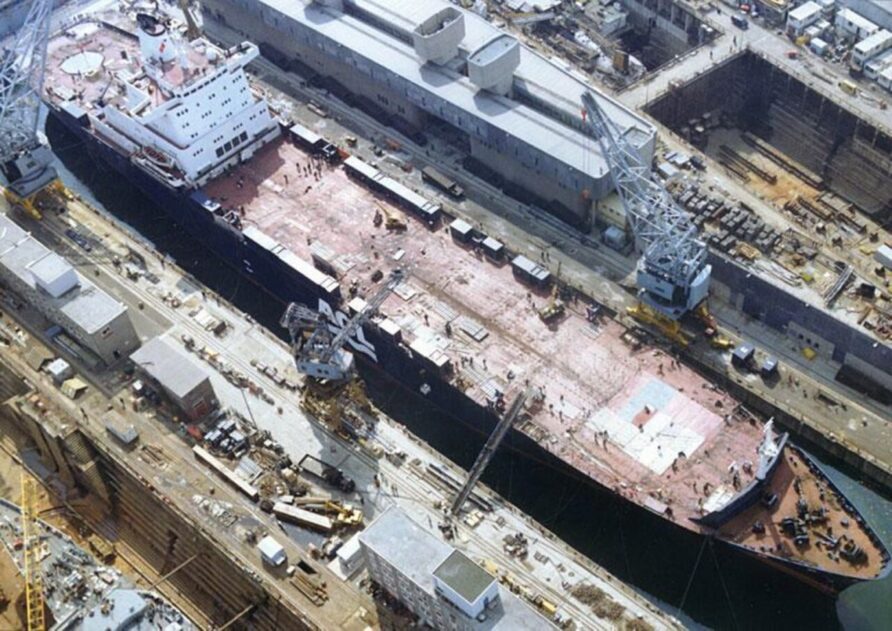
The strict container deck was additionally modified for helicopter operations.

The picture beneath exhibits Captain Ian North (left) and Royal Navy Captain Mike Layard (proper) on the bridge throughout conversion.

As described above, the unique plan for the Atlantic Conveyor was to make use of her as an plane ferry solely, however throughout some conferences on the seventeenth and twentieth of April 1982, it was determined to utilize the dear cargo areas for different activity drive shops.
Due to these last-minute selections, no further journal capability was put in. As a substitute, 600 cluster bombs, rocket motors, anti-tank missiles, grenades and small arms ammunition had been saved in regular containers.
This is able to have a major bearing on the aftermath of the assault.

The car decks had been used for all method of navy shops together with:
Tentage and tent heaters for the whole activity drive
11 Squadron RE’s G10 shops,
Gear and plant for the deliberate Harrier Ahead Working Base (FOB)
Stacker vehicles
Twelve Fight Assist Boats
Specialist spares
Dracones (floating rubber gas tanks)
Gasoline pumping tools
Water desalination tools
Mills
Lighting units
Non-aircraft munitions.
Helicopter and Sea Harrier (809 NAS) operations had been additionally examined and confirmed, certainly an unbelievable feat by Naval and civilian personnel, simply to remind you of the time scale, 10 days.
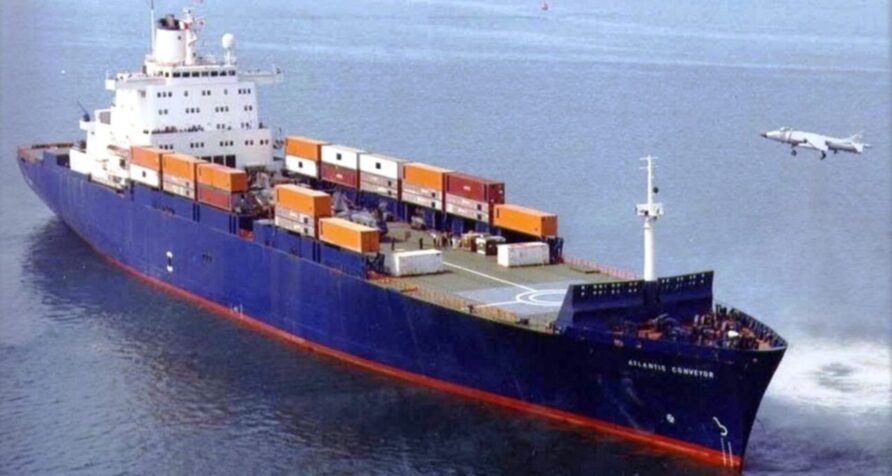
5 Chinook HC.1’s of No. 18 Squadron RAF had been flown to the Atlantic Conveyor, rotor blades eliminated and the airframes protected with Dri-Clad covers and corrosion inhibitors.

Becoming a member of the Chinooks had been additionally six Wessex HU.5 of 848 NAS and a small variety of Military Air Corps Scout helicopters.

RAS trials had been carried out on the twenty fourth of April 1982.
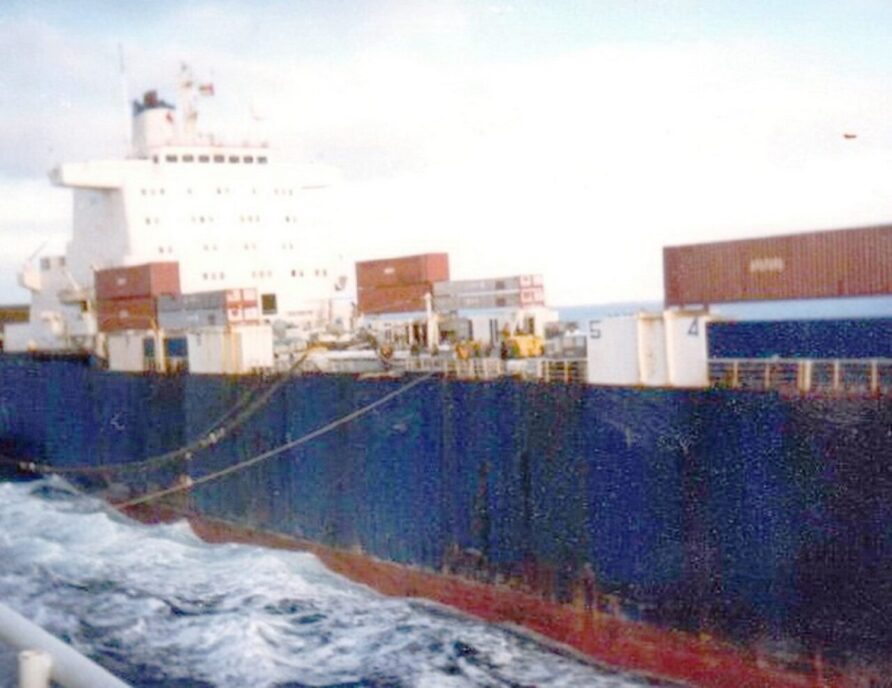
With Harrier GR.3 modifications and coaching nonetheless ongoing, the ship set sail for Ascension Island on the twenty fifth of April 1982

Becoming a member of the Atlantic Conveyor for the voyage to Ascension Island had been the MV Europic Ferry and MV Norland.
After departure, plenty of the containers used for gas storage leaked, and the aftermath of that will take a substantial amount of effort to resolve.
The Voyage South
On the 2nd of Might, she arrived in Freetown, Sierra Leone, for refuelling and replenishment
As soon as full she then sailed for Ascension Island.
The day after, the Harriers started their complicated and demanding journey south.

Three days later, on the fifth, she arrived on the by then, buzzing, Ascension Island.
Shops had been offloaded, loaded and re-stowed.
One of many Chinook’s was additionally embarked for use for transferring shops between ships.
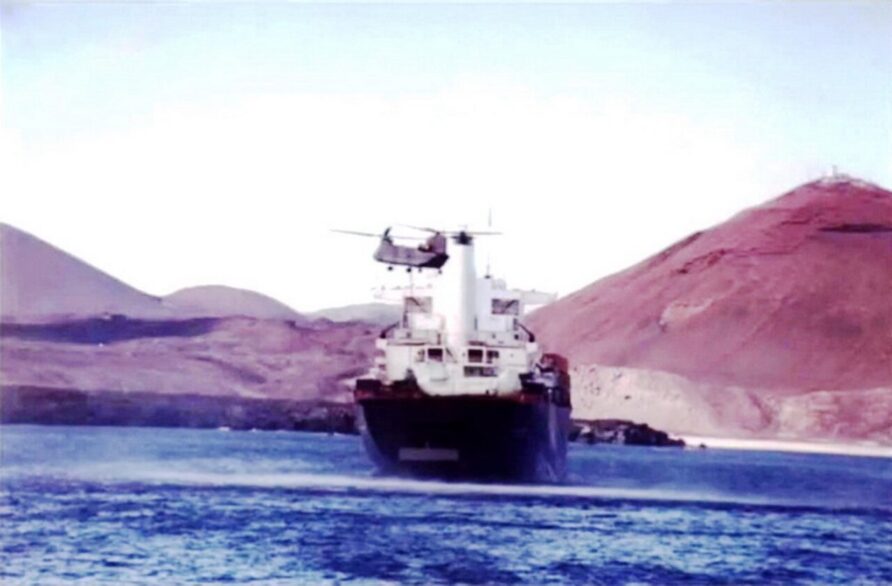
The Sea Harriers and Harrier GR3s, after a collection of record-breaking single-seat ferry flights from the UK arrived at Ascension

Then flown onto the Atlantic Conveyor.
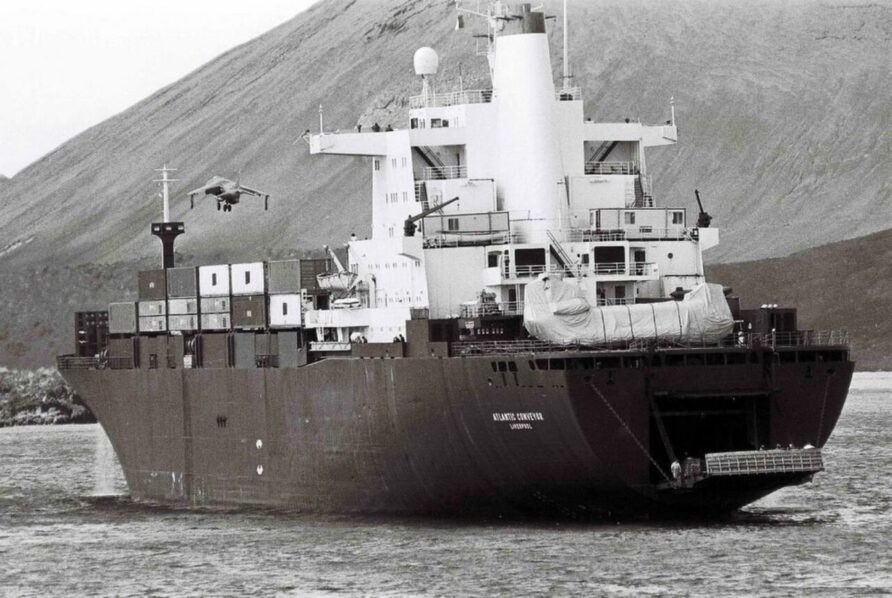
A fancy collection of plane actions culminated in all plane being stowed for the onward journey to the Falkland Islands, eight Sea Harriers and 6 Harrier GR3s had been to be carried south.

The ship left on the night time of the seventh of Might and the following day, the Harriers had been lined with the identical Dri-Clad baggage that protected the helicopters.
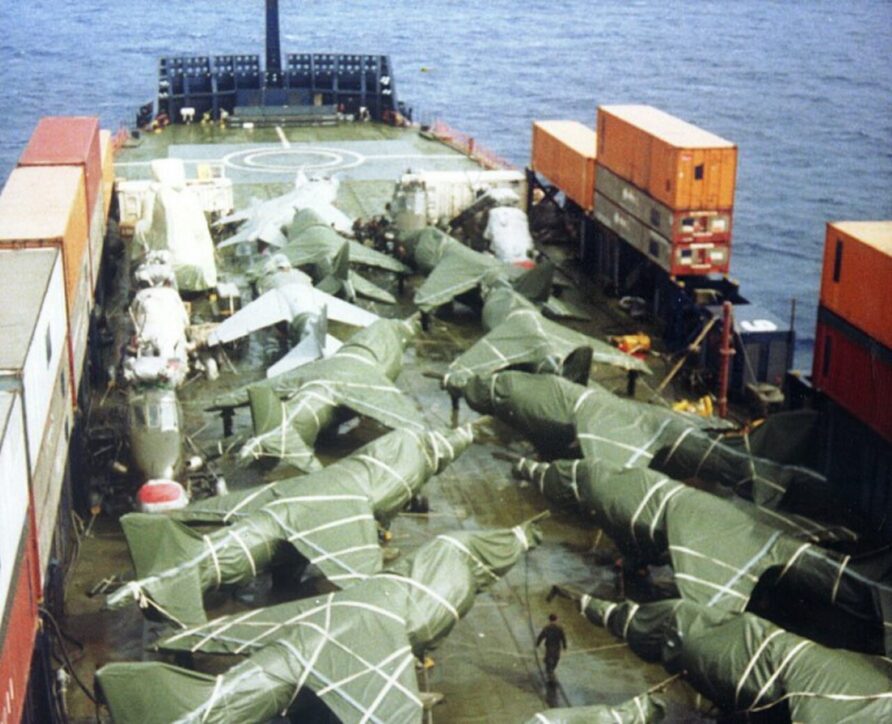
The journey to the Maritime Exclusion Zone (MEZ) took till the nineteenth of Might and through that point, one Sea Harrier was saved on ‘Deck Alert 20’ within the ‘anti-shadower’ function to guard towards Argentine Air Pressure 707 reconnaissance flights.
With no tanker assist, rising temperatures and a fuel-intensive vertical take-off and touchdown, the mission would have been very difficult.
Wessex helicopters had been used to switch personnel and shops between the Atlantic Conveyor and the remainder of the amphibious group crusing south.
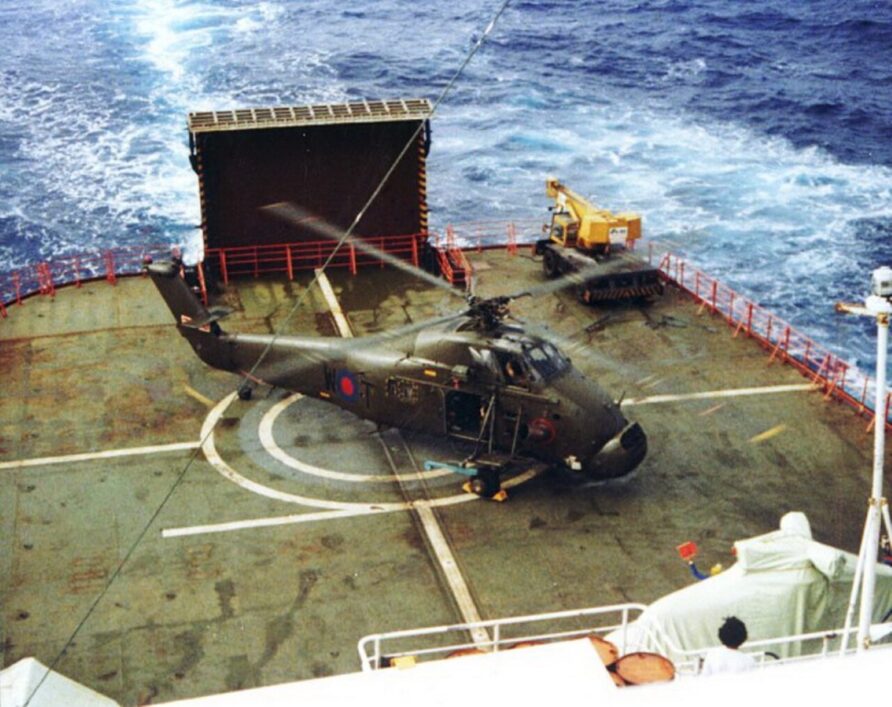
Process Pressure Rendezvous
Because the Atlantic Conveyor approached the Maritime Exclusion Zone the Harriers had been de-bagged (cease laughing on the again) and additional preparations had been made for disembarkation.
HMS Hermes and HMS Invincible closed with the amphibious group on the nineteenth of Might to permit the plane to switch from the Atlantic Conveyor.
With a number of engine issues and troublesome situations, this switch took barely longer than deliberate however by the twenty first of Might, all of the Harriers had been gone.
Throughout this brief interval, the Atlantic Conveyor stayed in shut proximity to the Battle Group, offering helicopter cargo assist by which one Chinook and three Wessex had been used extensively.
The primary Chinook used was the well-known Bravo November, flown off the entrance deck, after being debagged and bladed shortly earlier than.
Subsequent, to be ready was Bravo Tango, however her departure was to not be (see photos beneath)
Shops and munitions had been additionally transferred and a Lynx disembarked.
With the Harriers not on board, the principle mission of the Atlantic Conveyor had been achieved.
Exocet
On the night time of the twenty first of Might 1982, the beachhead at San Carlos was established, with follow-on landings happening quickly after.

By the twenty fourth, commanders felt rising optimism; the beachhead had been secured, shops had been being constructed up and mixed forces had began to realize the higher hand within the air conflict, regardless of important losses.
Argentine commanders appropriately assumed that the chance to dislodge British forces from San Carlos had handed and their finest plan of action was to disrupt the sustainment of the blockade.
The Atlantic Conveyor was instructed to be prepared to maneuver to San Carlos Water on the twenty fifth of Might below cowl of darkness to disembark all helicopters and start transferring all shops utilizing Mexeflote’s and touchdown craft at first gentle.
Preparations on-board continued, together with transferring shops to disembarkation factors and ‘floor testing’ of a few of the remaining helicopters.
Captain North reportedly mentioned to his crew;
Effectively boys, its Might twenty fifth, one thing spectacular ought to occur in the present day
In the meantime, two Tremendous Etendards of CANA 2 Esc approached from the north after refuelling from a Hercules tanker.
A Chinook helicopter, Bravo November, after static engine assessments, departed the ship from the ahead deck for additional testing and to switch some shops, and Bravo Tango moved to the rear deck in readiness for flight testing.
Through the remaining preparations of Bravao Tango, the decision ‘Handbrake’ was acquired on board the RN ships, indicating a detected Tremendous Etendard radar emission.
At 19.40, ‘Emergency Stations’ was sounded by the Atlantic Conveyor’s ship alarm.
Various warships together with HMS Alacrity deployed chaff countermeasures however while lured into the chaff cloud, the missiles flew by means of it and detected the Atlantic Conveyor.
She was hit by each missiles at C Deck.
The picture displaying the missile tracks beneath is taken from a now-declassified SECRET memo to the cupboard on the 2nd of June 1982.

There’s some distinction of opinion in public paperwork whether or not one or two missiles hit the Atlantic Conveyor.
The official Board of Inquiry acknowledged two and three diary extracts from the HMS Sensible web site would additionally appear to substantiate that.
Our weapon methods locked onto each the missiles and tracked all of them the best way in however they had been unable to have interaction them as a result of they had been out of vary. She was on fireplace inside minutes of being hit and it was getting darkish we had been instructed to get in as shut as we may and decide up individuals in life rafts.
We picked up a life raft with about 24 in whereas we had been doing this about 5 floated previous, they appeared lifeless a pair had put their survival fits on incorrect and had been floating toes up. I believe they had been picked up by helicopter. It was a horrible feeling figuring out it may have been you and so it goes on
and
The Captain put the ship into defence watches at 7.30 however I stayed within the Ops Room and we had an EW detection of Etendard radar at about 7.40, then shortly after this an unknown contact to the NW.
We then noticed them – contacts double (clearly missile launch) because the missiles began in. The system instantly acquired them and the T.V. screens confirmed them heading some 5 miles NW of us towards the Atlantic Conveyor.
The missiles had been so shut collectively they had been each on the identical T.V. monitor. They had been v. low and v. quick. We noticed them hit the center of the “Conveyor” and the explosion appeared to undergo her and out the opposite aspect.
Lastly,
Whereas the rescue try had been being carried out on Coventry two low plane had been noticed at about 26 miles away from the drive. They launched Exocet missiles at 23 miles All of the ships fired Chaff which is simply bits of silver paper it labored for a second however the missiles locked on once more straight into the strict of the Atlantic Conveyor.
The Board of Inquiry acknowledged the next;
ACO hit by two Exocet, port quarter degree with after finish of superstructure, 10-12 toes above waterline. Missiles entered C cargo deck in neighborhood of carry shaft. Ship in a port flip passing by means of roughly 90 levels on the time
A number of sources are clear that it was two missiles.
HMS Alacrity got here alongside to aim boundary cooling and RFA
Sir Percival additionally stood off the port quarter to render help.
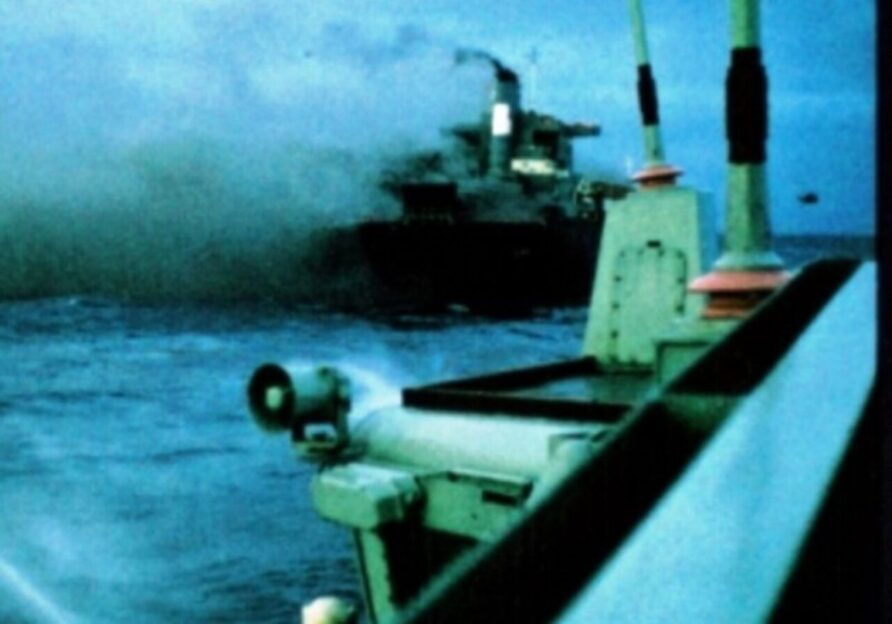
Shrapnel was reported to be seen coming by means of the ship’s sides as ammunition and fuel cylinders had been exploding, regardless of this, helicopters rescued twenty-two personnel from the ahead deck.

Injury management and firefighting continued, and ammunition was dumped overboard, however it was a dropping battle, with methods failing and lightweight fading quick, the choice was made to desert ship at 20.05, 25 minutes after the assault.
The fires had been assessed as being uncontrollable with a excessive danger of spreading to the ahead maintain the place appreciable portions of kerosene and cluster bombs had been saved.
Unable to land on the ship, Bravo November landed on the plane service, HMS Hermes.
The ship’s captain threatened to have the Chinook pushed overboard if it was not eliminated as a result of it might hamper the service’s potential to mount its personal air operations. After an in a single day keep the plane departed for the bridgehead at San Carlos.
Regardless of the valiant efforts of these concerned, twelve males misplaced their lives. Three had been misplaced on board and 9 after getting into the water.
In whole, 100 and thirty-seven out of the 100 and forty-nine on board had been rescued, clearly an amazing credit score to all concerned and a testomony to the calm and orderly method by which the ship was deserted.
The final lifeboat was recovered by HMS Alacrity at 23.00.
The 12 males killed within the sinking of the Atlantic Conveyor had been:
Service provider Navy
Bosun (Petty Officer I) John B. Dobson
Mechanic (Petty Officer I) Frank Foulkes
Assistant Steward David R. S. Hawkins
Mechanic (Petty Officer II) James Hughes
Captain Ian H. North, DSC
Mechanic (Petty Officer II) Ernest M. Vickers
Royal Fleet Auxiliary
First Radio Officer Ronald Hoole
Laundryman Ng Por
Laundryman Chan Chi Shing
Royal Navy
Chief Petty Officer Edmund Flanagan
Air Engineering Mechanic (R) Adrian J. Anslow
Main Air Engineering Mechanic (L) Don L. Pryce
I assumed this, from the London Gazette for Captain North was becoming.
Captain Ian Harry NORTH, Service provider Navy. On 14th April 1982 SS ATLANTIC CONVEYOR was laid up in Liverpool. On the twenty fifth April she deployed to the South Atlantic transformed to function mounted and rotary wing plane and loaded with shops and tools for the Falkland’s Process Pressure. This astonishing feat was largely resulting from Captain North’s innovation, management and inexhaustible power.
SS ATLANTIC CONVEYOR joined the Service Battle Group on nineteenth Might 1982 and was instantly handled as a warship in most respects. Virtually comparable in manoeuvrability, flexibility and response Captain North and the ship got here by means of with flying colors. When the ship was hit on twenty fifth Might Captain North was a tower of energy in the course of the troublesome interval of injury evaluation main as much as the choice to desert ship. He left the ship final with huge dignity and calm and his subsequent dying was a blow to all.
A superb seaman, courageous in conflict, immensely revered and liked his contribution to the Marketing campaign was huge and epitomised the good spirit of the Service provider Service
And one other.
Third Engineer Brian Robert WILLIAMS, Service provider Navy.
On the time when ATLANTIC CONVEYOR was hit by Exocet missiles. Mr Williams, the Engineer Officer was stationed on watchin the Engine Management Room with the mechanic. Quickly after the missiles hit, the mechanic left the room and shortly after this was heard calling for assist. The room was filling with smoke and would shortly be deserted. Nonetheless Mr Williams promptly placed on respiration equipment and set off to the rescue of the mechanic whom he discovered, following an extra giant explosion, significantly injured and trapped in a manner that help can be required to launch him.
Mr Williams went shortly to get assist.
Then, realising {that a} additional rescue mission was a forlorn hope and figuring out that there was a grave danger of additional explosions and the unfold of fireside, he armed himself with asbestos gloves and contemporary respiration equipment and accompanied by the Physician and a PO Engineer once more braved the appalling warmth and smoke for an extra try and rescue the mechanic. Nonetheless, as they approached, the situations turned actually insufferable and the mission needed to be deserted. Mr Williams made his report calmly after which went to the Respiration Equipment retailer the place he started valiant efforts to recharge air respiration bottles. He was ultimately ordered to the higher deck to desert ship.
All through the incident Mr Williams confirmed distinctive bravery and management and a complete disregard for his personal security
Courageous males all.
A Wessex helicopter from HMS Hermes photographed the still-burning ship the day after the assault.
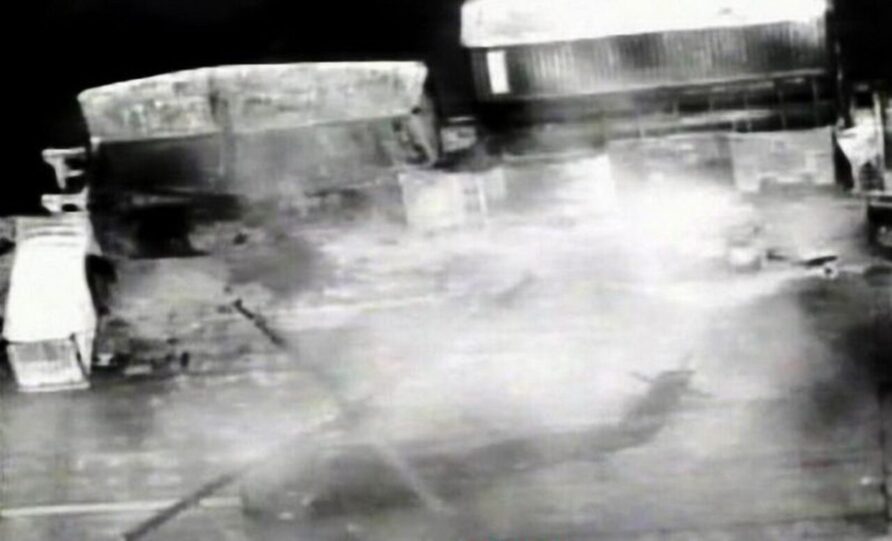
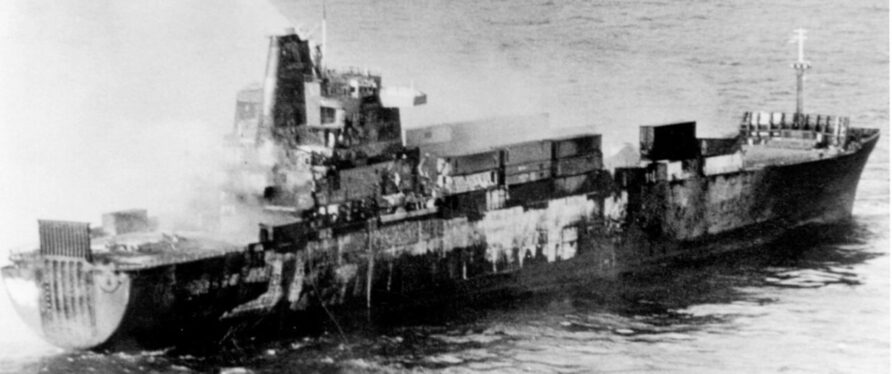
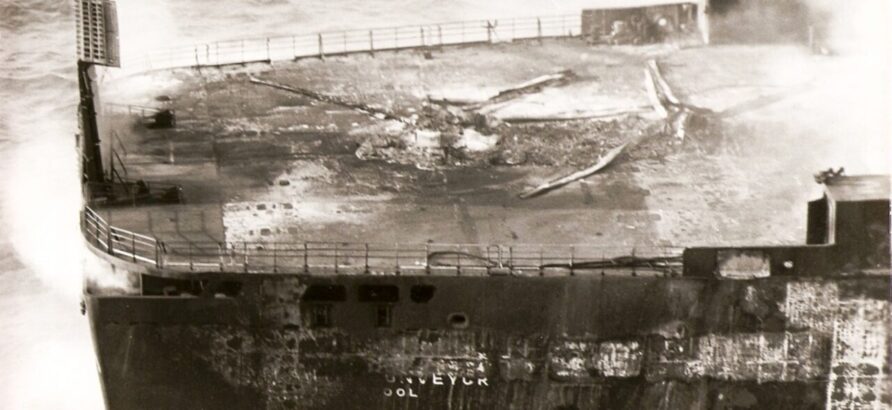
On the twenty seventh at 50305 5451W, the Atlantic Conveyor was once more sighted and though the bow part had been utterly destroyed by exploding cluster bombs and gas, a choice was made to aim to deliver her below tow utilizing the tug, The Irishman, one of many STUFT vessels.
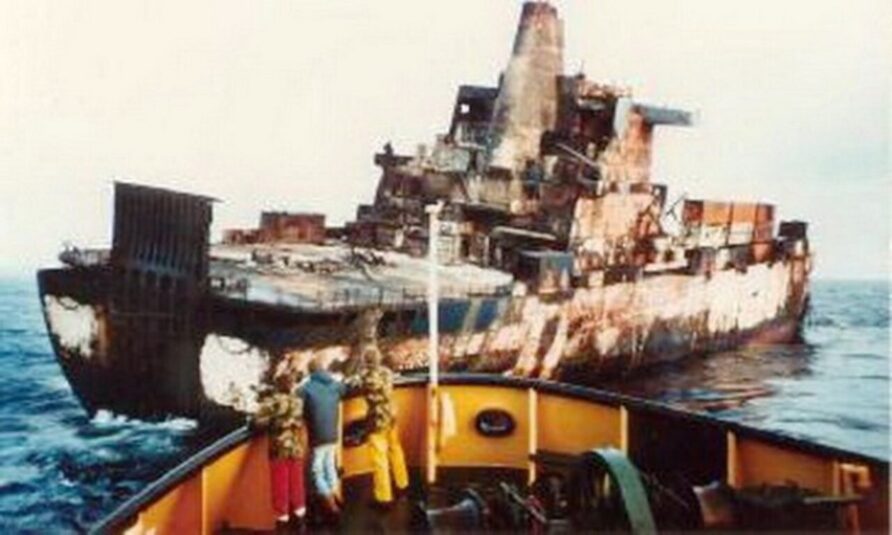
Regardless of repeated efforts of the crew of The Irishman, she sank within the early hours of the twenty eighth of Might, 1982.
Three containers had been sighted floating on the place the place it was assumed she sank.
A handful of feedback from an older model of this textual content on the Assume Defence weblog.
The Conveyor was with us as we had been cross decking harriers and equipment all day. I can keep in mind the motion station alarm going off and the urgency within the voice of the particular person sounding the alarm and we knew it was shut. After I closed as much as my motion station I obtained kitted up I opened the climate deck entry door for a peek to see what was taking place. I may see her clearly ablaze particularly across the superstructure lads working up and down the deck donning there as soon as solely survival fits and going over the aspect as she was that near us. Then all of the helicopters began closing in on her and winching up the lads out of the water and from the life rafts. I knew a number of of the lads who had been on her and so they had been introduced over to us. It appeared fairly humorous on the time in an odd manner and we had been taking the piss out of them (gallows humour I suppose) then I can keep in mind taking a look at them and seeing the shock of their eyes and the truth of what had simply occurred to them sank in. Had she not taken the hit wouldn’t it have taken us?
Hermes 82
I used to be launched into the Conveyor (848 NAS) at the moment. There has at all times been a debate as as to whether we had been hit by one or two missiles – it doesn’t actually matter I suppose, regardless of gallant efforts, there was nothing we may do to avoid wasting her. The lone query I’ve at all times carried with me is, if she was so vital to the success of the landings, why weren’t we higher protected?
Peter Burris
I used to be spreading the rotors of the Wessex 5 simply aft of the ahead flight deck once we had been hit. A scary time for a younger 19-year-old, however just lately my thoughts has been blown away by a undeniable fact that I learn within the “Board of Enquiry” of the sinking of the AC. I used to be rescued by a Wessex 5 of 845 Squadron “YD” XT459. I didn’t know this till final week after I learn the report. In December 1983, I used to be on operation “Clockwork” in northern Norway, left-hand seat in “YD” once we spiralled in nostril first from 1200ft. I’m in shock that the identical plane rescued me, then 19 months later practically killed me!
Phil Russo
I used to be on the Alacrity on the time we had detected the Etendards and had fired chaff ensuing within the conveyor being hit. we spent the following few hours first tied up alongside making an attempt to firefight and rescue survivors however it was too tough and we had been getting smashed collectively. We then stood off and put swimmers into rescue survivors and recuperate a few of these much less lucky.
Stevey
Was serving aboard HMS Alacrity on the time. As I recall the Exocet(s) had been geared toward us and the carriers, however we despatched up a great deal of chaff which confused the missile(s), which carried on previous us after which, as programmed, they hunted for the following giant object which occurred to be Atlantic Conveyor, a few mile away from us? Alacrity was first alongside, and as Stevey appropriately acknowledged, it was far too tough for us to remain alongside for lengthy, particularly because it turned out that the Alacrity’s hull was already in poor situation as a result of battering it took down south. I recall vividly hauling some our bodies on board, we had nowhere to retailer them, so we needed to quickly stow them in one in every of our ammunition shops. It was one other horrible day, coming solely 4 and two days after dropping two of our sisters, Ardent and Antelope respectively. Morale was fairly low for a time. Dave “Bungy” Williams WEM(R)1
David J Williams
Definitely introduced again a number of reminiscences for me! 54 service provider ships had been taken up from commerce (STUFT) to help the armed forces in the course of the South Atlantic battle. 43 sailed for the South Atlantic with Service provider Navy crews and Naval Events embarked, earlier than the Argentine give up on fifteenth June
Commander Nick Messinger RD** FNI RNR Retd
Aftermath
Though the lack of the Atlantic Conveyor in the end didn’t change the results of the marketing campaign and her major mission of delivering the dear Harriers and Sea Harriers accomplished, her loss can be acutely felt.
Along with the large quantity of shops, three Chinook, six Wessex and a Lynx helicopter had been misplaced, together with all their specialist instruments, spares and manuals.
The unique plan referred to as for the Chinooks from Atlantic Conveyor to maneuver a complete Commando to safe Mount Kent with one other Commando and Parachute Battalion to Teal Inlet and Douglas Settlement.
The information of the Atlantic Conveyors’ loss got here as a bitter blow.
We’ll should bloody nicely stroll then
The remaining Chinook, the well-known Bravo November, can be saved flying with borrowed instruments and improvised engineering however one factor was sure, the path to Stanley can be made largely on foot.
Though Sea King and Wessex helicopters may each carry exterior sling hundreds, they had been on no account akin to that of the Chinook.
With just one Chinook obtainable, priorities would imply that it might be largely used for supporting the Royal Artillery Mild Weapons.

No large-scale strikes of infantry forces by helicopter had been potential and many of the troops needed to stroll (tabbing or yomping, relying on the color of your beret) as much as fifty miles throughout East Falkland, from San Carlos to Stanley, earlier than beginning the principle assault, a feat of arms that’s nonetheless notable in the present day.
The influence of a scarcity of helicopter carry on the choice to assault Goose Inexperienced and the next ways is fascinating to debate however probably the most important influence can be the choice to ship 5 Infantry Brigade to land at Bluff Cove with its subsequent losses.
One other important implication of the sinking was on plans for the Harrier Ahead Working Base (FOB) at San Carlos.
It was an enormous blow to the development of the FOB, compounded by the truth that most of the Sappers’ autos had been unable to be offloaded from RFA Sir Lancelot due to unexploded bombs.
On the SS Atlantic Conveyor had been all of 11 Squadron’s shops, i.e. the FOB and the means to create it (engineering plant and many others.).
All was not misplaced, although, supplementing the preliminary shops getting used to construct the FOB, on RFA Stromness was a small amount of PSA (Prefabricated Surfacing Airfield) panels that had been used for bomb harm restore and vertical take-off and touchdown pads.

The lack of gas dracones and related pumping and storage tools meant gas was at all times an issue, arguably, the duty drive wouldn’t have been capable of maintain the three Chinook helicopters misplaced in any case with out it.
On eleventh June the British drive mounted a brigade-sized night time assault on Argentine positions within the mountains surrounding Stanley and three days later, after heavy combating within the space, the Argentine garrison surrendered.
As a result of the Process Pressure tentage, heaters and many of the mills and lighting units had been misplaced with the Atlantic Conveyor, post-ceasefire preparations can be extraordinarily difficult till further shares might be transported south.
Controversy
There stays to at the present time some controversy in regards to the degree of safety afforded the Atlantic Conveyor, why one of many two Seawolf armed Kind 22 frigates was not assigned to escort her, why no self-protection measures had been put in and whether or not, given the importance of the twenty fifth of Might, she was in a hazard space within the first place.
After the BOI report was launched in 2007 the newspapers printed the headline-grabbing information that Atlantic Conveyor was left defenceless over issues about legality.
From the Occasions, December eleventh 2007
A helicopter-carrying service provider ship that sank with the lack of 12 males after being hit by two Exocet missiles within the 1982 Falklands battle was unarmed and unprotected as a result of Ministry of Defence attorneys feared that it was unlawful to suit a business vessel with weapon methods, in accordance with newly launched categorised paperwork
The total BOI report may be discovered right here, which incorporates an intensive narrative and a substantial amount of supplementary data together with data on how the explosives, ammunition, bombs and different hazardous shops had been stowed.
The important thing elements are in Attachments 1 and a pair of, these cowl the topic of self-protection measures, stowage and harm management points.
The vessel may need been stationed additional east till the Chinooks had been able to fly off, and a few of the FOB shops and engineering plant distributed on different vessels, maybe she may have presumably stayed in a safer space till the Seawolf-armed HMS Andromeda arrived on the twenty sixth.
It’s straightforward to see issues with good 20:20 hindsight and be clever after the occasion however I believe any dialogue should bear in mind the extremely brief time by which conversion and operations happened and the comparative dangers to the operational success of defending the Atlantic Conveyor and defending the carriers.
Powerful occasions wanted robust selections.
Sister
The Atlantic Conveyor had a much less well-known sister ship that additionally took half in operations within the South Atlantic.
The Atlantic Causeway was pressed into service in the identical time-frame however with a special set of modifications.
Requisitioned on the 4th of Might and brought to Devonport on the sixth, she was transformed to hold, function and assist helicopters.
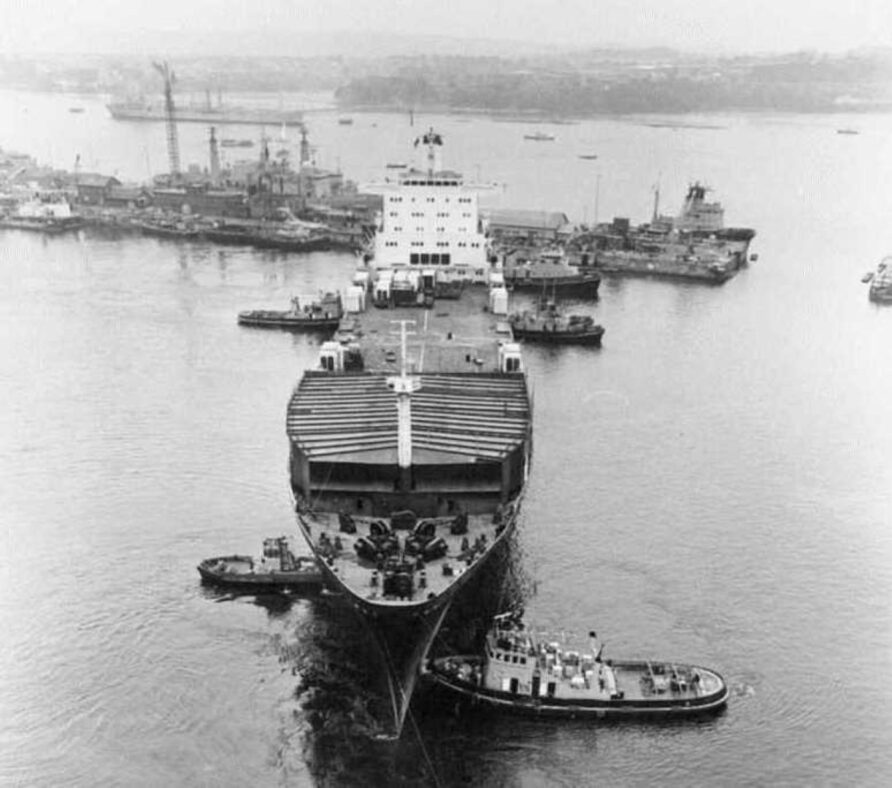
The conversion differed from the Atlantic Conveyor in having a big hangar ahead and improved aviation gas dealing with amenities that supported working helicopters, not simply transporting them.
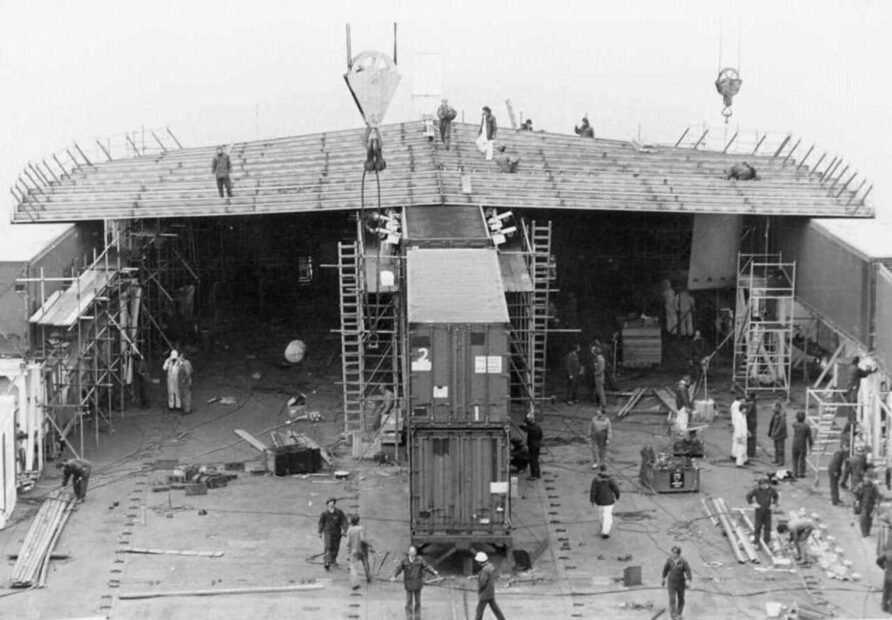
Atlantic Causeway sailed on the 14th of Might with 28 helicopters and arrived within the Complete Exclusion Zone (TEZ) on the twenty seventh of the identical month, disembarking her plane and shops in San Carlos Water from the thirty first of Might.

From Hansard;
HC Deb 22 December 1983 vol 51 c424W 424W
Mr. Dalyell requested the Secretary of State for Defence what has been the price of changing the Atlantic Causeway right into a ship able to carrying helicopters.
Mr. Lee The Atlantic Causeway was taken up from commerce and transformed to move plane and shops in the course of the Falklands emergency. She has since been restored and returned to her homeowners. The overall price of conversion and restoration was about £2 million.
Through the operation, she acquired 4000 helicopter landings and refuelled plane 500 occasions, a formidable feat for conversion and restoration that price £2 million.
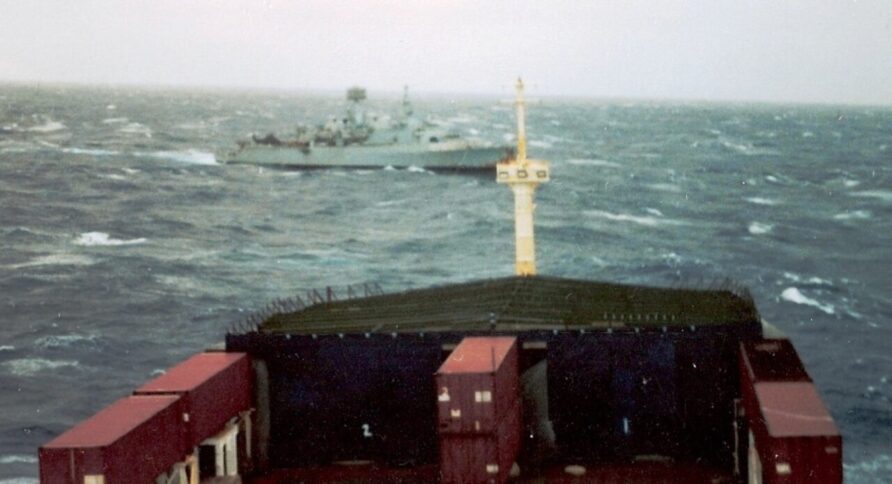
One other couple of service provider conversions are additionally price mentioning, though not of the identical design, MV Astronomer.
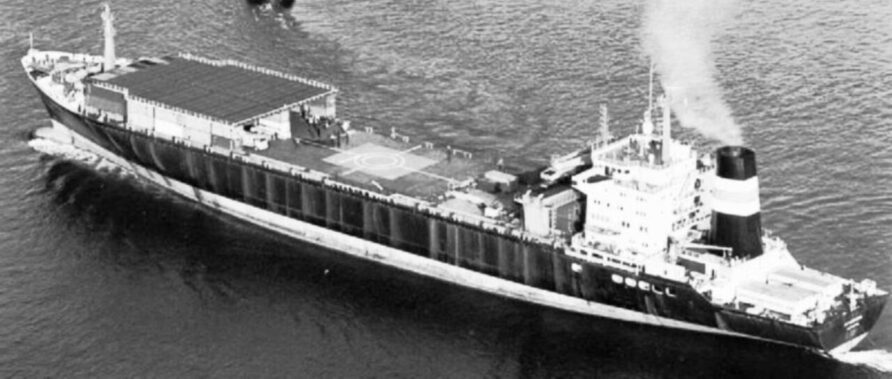
After unloading all cargo and containers, she was sailed to Devonport and transformed to the helicopter ahead assist ship, crusing South on the eighth of June 1982.
The six-day conversion included the set up of a touchdown pad, hangar, RAS gear, communications tools, further lodging and self-defence tools.
Along with three Chinook, Wessex and Sea King helicopters, the ship had its crew of 34 joined by 53 Royal Navy, 21 RAF and eight Military personnel.
Throughout her time within the Falkland Islands, the MV Astronomer carried out all method of aviation assist, patrol and logistics actions.
The one-thousandth touchdown was accomplished by a Royal Navy Sea King from HMS Invincible by the tip of August.
And MV Contender Bezant, or RFA Argus as she would later turn out to be.
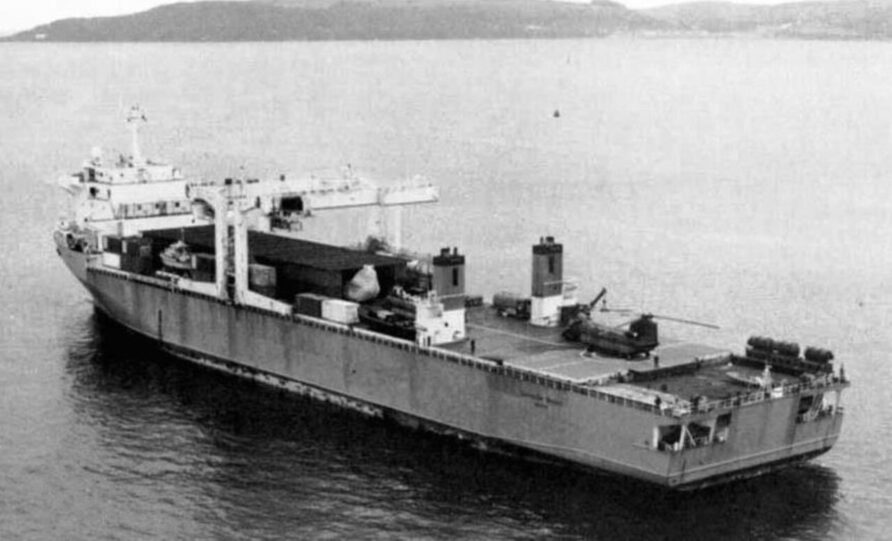
MV Contender Bezant was utilised as an plane transport, ferrying helicopters and Harriers south to the Falkland Islands.
Following buy by the MoD in 1985 for £13million she was transformed to an aviation coaching ship on the shipyard of Harland & Wolff, Belfast, with the addition of prolonged lodging, a flight deck, plane lifts and naval radar and communications suites. A Main Casualty Receiving Facility was added earlier than Argus was despatched to take part within the 1991 Gulf Battle.
One other function of RFA Argus is that of RORO car transport with autos carried within the hangar and on the flight deck, a job she carried out in assist of United Nations operations within the former Yugoslavia.
Through the 2003 invasion of Iraq, Argus was once more current within the Persian Gulf as an offshore hospital for coalition troops, incomes the nickname “BUPA Baghdad”.
Most famously, RFA Argus participated in OP GRITROCK, the UK’s response to the Ebola outbreak in Sierra Leone, and naturally, a star flip within the Brad Pitt movie, World Battle Z.
ZA718 Bravo November
No story of the Atlantic Conveyor can be full with out some reference to the one which obtained away, Bravo November
Through the assault on the Atlantic Conveyor, Bravo November was transferring a netted cargo of Lynx spares and was due to this fact nonetheless within the air, after being ordered to carry the place for a brief interval the helicopter returned to HMS Hermes.
The massive Chinook on the crowded deck of HMS Hermes brought about some issues for plane motion and consideration was given to sawing the blades off and stowing it beneath and even dumping it over the aspect in finest Vietnam style.
Fortunately, these choices had been ultimately discounted and the following morning it was refuelled and flown to the Falkland Islands.
In a single mission, it carried 28 males and two 105mm Mild Gun within the cabin, plus one other Mild Gun slung, will need to have been a decent squeeze!
One other mission included carrying 81 totally tooled-up Paras to Fitzroy, sure, 81.
From commencing operations till the Argentine give up, Bravo November moved 1,530 troops, 650 POW’s and 1,600 tonnes of shops.
It’s troublesome to see how the Royal Artillery may have saved up the extraordinary Mild Gun firing price with out the heavy carry offered by Bravo November.
Memorial
In June 2007 a memorial to these misplaced on the Atlantic Conveyor was unveiled at Cape Pembroke, probably the most Easterly level on the Falkland Islands, close to the now disused lighthouse.

Up till that time, she was the one vessel sunk within the battle with out a memorial.
The memorial incorporates a propeller and shaft that has been aligned on a magnetic bearing of 62 levels to point the purpose, 90 miles out, the place the MV Atlantic Conveyor lastly got here to relaxation.
In 2008 the Safety of Army Stays Act (PMRA) 1986 was prolonged to incorporate the Atlantic Conveyor
A Lighter Word
Thought I might finish this on a lighter be aware, an city fable maybe, however a great one.
As a result of it was not completely clear what shops had been on board, it was mentioned for years after the sinking, each enterprising Quartermaster (QM) within the British Military seized the chance and indented for tools that supposedly ‘went down on the Atlantic Conveyor’
The quantity of equipment thus claimed would have been sufficient to fill a number of Atlantic Conveyors.
The perfect one I heard was that some outdated tentage, nonetheless on the books from the Boer Battle, was lastly written off as being misplaced on the Atlantic Conveyor!
Change Date Change Document 01/03/2017 preliminary difficulty 12/01/2021 Format replace and inclusion of further data acquired in feedback 14/07/2021 Refresh and replace 24/08/2023Refresh and replace
Associated
[ad_2]
Source link



